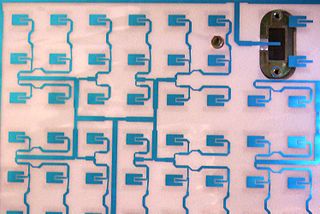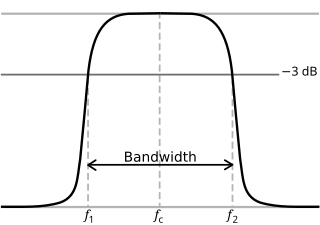
A fractal antenna is an antenna that uses a fractal, self-similar design to maximize the effective length, or increase the perimeter, of material that can receive or transmit electromagnetic radiation within a given total surface area or volume.

Freedom of Mobile Multimedia Access (FOMA) is the brand name of the W-CDMA-based 3G telecommunications services being offered by the Japanese telecommunications service provider NTT DoCoMo. It is an implementation of the Universal Mobile Telecommunications System (UMTS) and was the world's first 3G service to commence operation.

The 3110 is a GSM mobile phone handset manufactured by Nokia in Hungary, introduced at CEBIT in March 1997. The 3110 is notable as the first Nokia handset to feature the 'Navi-Key' menu navigation system. The Navi-Key was featured heavily on Nokia handsets, especially the entry-level models such as the Nokia 1100 in the following years. Unlike its successor, the 3210, and subsequent handsets of similar design, the 3110 had an external antenna. The phone was available with a slim, standard or vibrating battery. It could only be used on a GSM-900 network.

The Nokia 3210 is a GSM cellular phone, announced by Nokia on 18 March 1999.
In a multielement antenna array, the driven element or active element is the element in the antenna which is electrically connected to the receiver or transmitter. In a transmitting antenna it is driven or excited by the RF current from the transmitter, and is the source of the radio waves. In a receiving antenna it collects the incoming radio waves for reception, and converts them to tiny oscillating electric currents, which are applied to the receiver. Multielement antennas like the Yagi typically consist of a driven element, connected to the receiver or transmitter through a feed line, and a number of other elements which are not driven, called parasitic elements. The driven element is often a dipole. The parasitic elements act as resonators and couple electromagnetically with the driven element, and serve to modify the radiation pattern of the antenna, directing the radio waves in one direction, increasing the gain of the antenna.

A patch antenna is a type of radio antenna with a low profile, which can be mounted on a flat surface. It consists of a flat rectangular sheet or "patch" of metal, mounted over a larger sheet of metal called a ground plane. They are the original type of microstrip antenna described by Howell in 1972; the two metal sheets together form a resonant piece of microstrip transmission line with a length of approximately one-half wavelength of the radio waves. The radiation mechanism arises from discontinuities at each truncated edge of the microstrip transmission line. The radiation at the edges causes the antenna to act slightly larger electrically than its physical dimensions, so in order for the antenna to be resonant, a length of microstrip transmission line slightly shorter than one-half the wavelength at the frequency is used. The patch antenna is mainly practical at microwave frequencies, at which wavelengths are short enough that the patches are conveniently small. It is widely used in portable wireless devices because of the ease of fabricating it on printed circuit boards. Multiple patch antennas on the same substrate (see image) called microstrip antennas, can be used to make high gain array antennas, and phased arrays in which the beam can be electronically steered.
A dielectric resonator is a piece of dielectric (nonconductive) material, usually ceramic, that is designed to function as a resonator for radio waves, generally in the microwave and millimeter wave bands. The microwaves are confined inside the resonator material by the abrupt change in permittivity at the surface, and bounce back and forth between the sides. At certain frequencies, the resonant frequencies, the microwaves form standing waves in the resonator, oscillating with large amplitudes. Dielectric resonators generally consist of a "puck" of ceramic that has a large dielectric constant and a low dissipation factor. The resonant frequency is determined by the overall physical dimensions of the resonator and the dielectric constant of the material.
FICA is the Federal Insurance Contributions Act tax.

A quad antenna is a type of directional wire radio antenna used on the HF and VHF bands. Like a Yagi–Uda antenna ("Yagi"), a quad consists of a driven element and parasitic elements; however in a quad, each of these elements takes the form of a loop of wire, which may be square, round, or some other shape. It is used by radio amateurs on the HF and VHF amateur bands.
The Nokia 6111 is a mid-level GSM mobile phone released in June 2005. It sold in Asia, Europe, Australia, Brazil and in Mexico, but was not taken by any carriers in the United States.

The AN/PRC-148 Multiband Inter/Intra Team Radio (MBITR) is the most widely fielded handheld multiband, tactical software-defined radio, in use with NATO forces around the world. The radio is built by Thales Communications, a subsidiary of the Thales Group. The designation AN/PRC translates to Army/Navy Portable Radio used for two way Communications, according to Joint Electronics Type Designation System guidelines.
PIFA or Pifa may refer to:

A gravitational-wave observatory is any device designed to measure gravitational waves, tiny distortions of spacetime that were first predicted by Einstein in 1916. Gravitational waves are perturbations in the theoretical curvature of spacetime caused by accelerated masses. The existence of gravitational radiation is a specific prediction of general relativity, but is a feature of all theories of gravity that obey special relativity. Since the 1960s, gravitational-wave detectors have been built and constantly improved. The present-day generation of resonant mass antennas and laser interferometers has reached the necessary sensitivity to detect gravitational waves from sources in the Milky Way. Gravitational-wave observatories are the primary tool of gravitational-wave astronomy.

The AN/PRC-117 Multiband Manpack Radio, or Multiband Multi Mission Radio (MBMMR), is a man-portable, tactical software-defined combat-net radio, manufactured by Harris Corporation, in two different version:
A dielectric resonator antenna (DRA) is a radio antenna mostly used at microwave frequencies and higher, that consists of a block of ceramic material of various shapes, the dielectric resonator, mounted on a metal surface, a ground plane. Radio waves are introduced into the inside of the resonator material from the transmitter circuit and bounce back and forth between the resonator walls, forming standing waves. The walls of the resonator are partially transparent to radio waves, allowing the radio power to radiate into space.
Mohamed Sanad is an Egyptian antenna scientist and professor in the Faculty of Engineering, Cairo University.
A Royer oscillator is an electronic relaxation oscillator that employs a saturable-core transformer. It was invented and patented in 1954 by George H. Royer. It has the advantages of simplicity, low component count, rectangle waveforms, and easy transformer isolation. By making maximum use of the transformer core, it also minimises the size and weight of the transformer. The classic Royer circuit outputs square waves; a modified version, essentially by adding a capacitor, turns it into a harmonic oscillator, outputting sine waves. Both versions are widely used, mainly as power inverters.

The G5RV antenna is a dipole with a symmetric resonant feeder line, which serves as impedance matcher for a 50 ohm coax cable to the transceiver.

An inverted-F antenna is a type of antenna used in wireless communication. It consists of a monopole antenna running parallel to a ground plane and grounded at one end. The antenna is fed from an intermediate point a distance from the grounded end. The design has two advantages over a simple monopole: the antenna is shorter and more compact, and the impedance matching can be controlled by the designer without the need for extraneous matching components.













